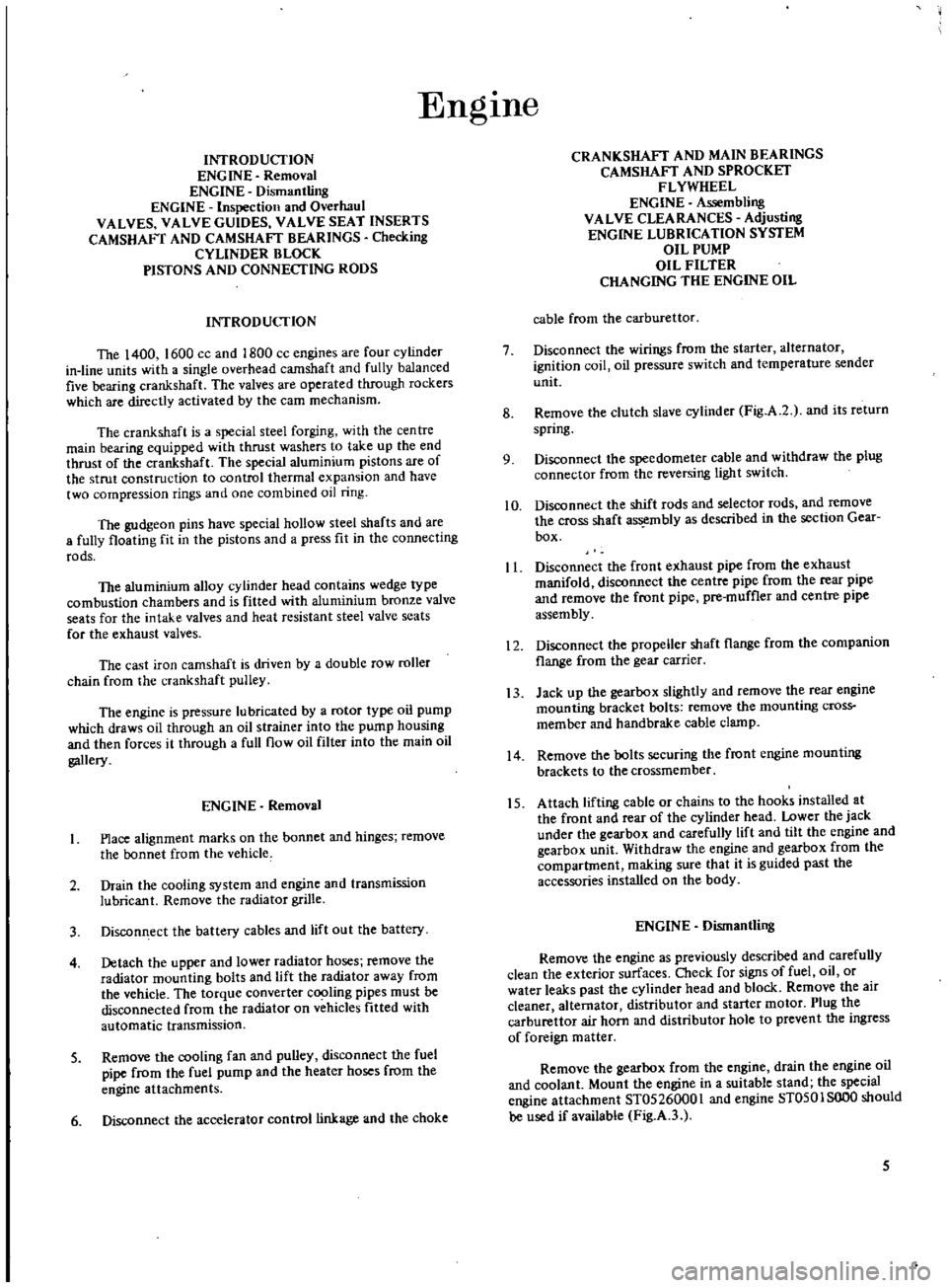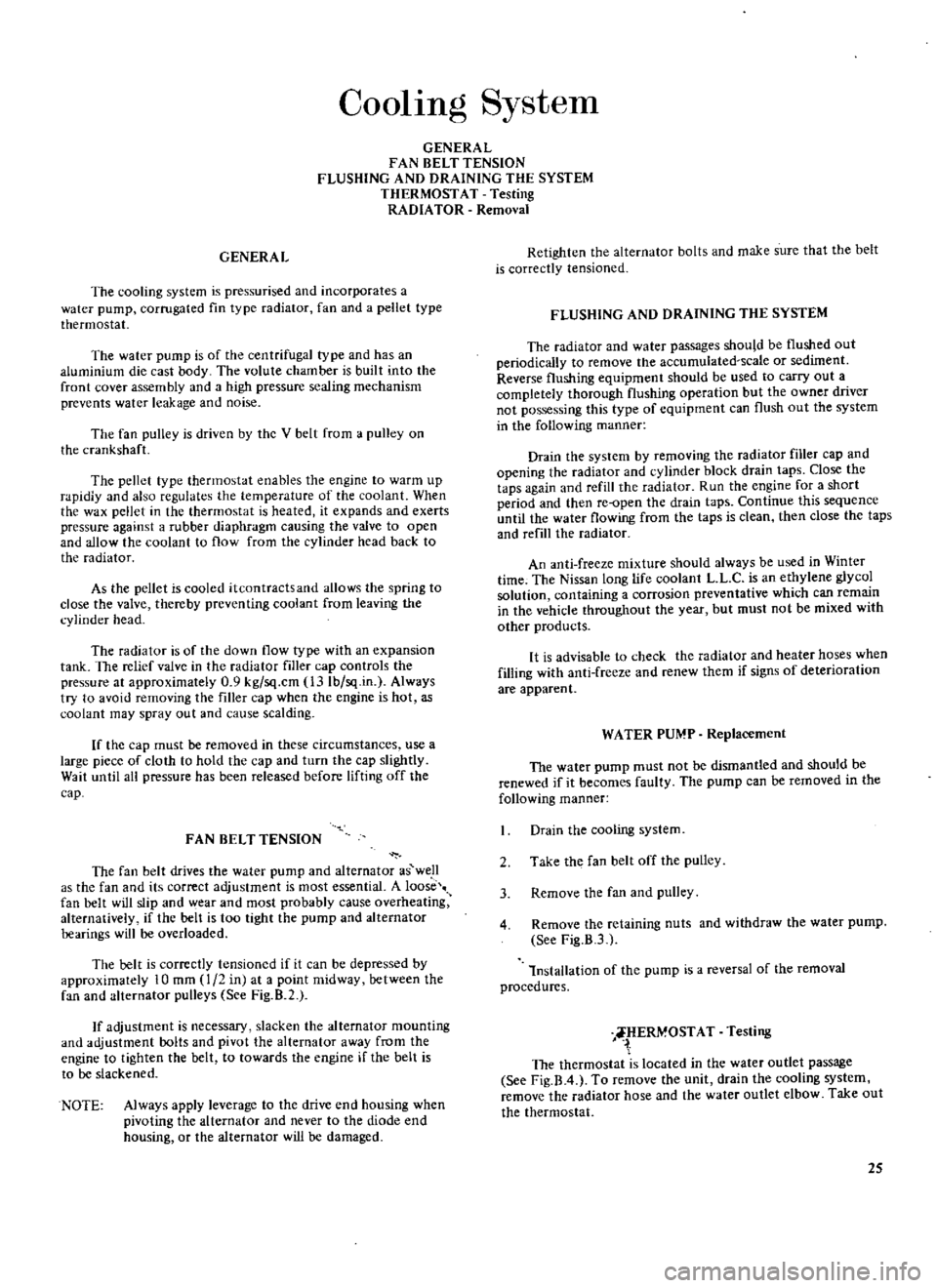coolant temperature DATSUN 610 1969 Workshop Manual
[x] Cancel search | Manufacturer: DATSUN, Model Year: 1969, Model line: 610, Model: DATSUN 610 1969Pages: 171, PDF Size: 10.63 MB
Page 6 of 171

EngIne
INTRODUCTION
ENGINE
Removal
ENGINE
DismantUng
ENGINE
Inspection
and
Overhaul
VALVES
VALVE
GUIDES
VALVE
SEAT
INSERTS
CAMSHAFT
AND
CAMSHAFT
BEARINGS
Checking
CYliNDER
BLOCK
PtSTONS
AND
CONNECTING
RODS
INTRODUCTION
The
1400
1600
cc
and
1800
cc
engines
are
four
cylinder
in
line
units
with
a
single
overhead
camshaft
and
fully
balanced
five
bearing
crankshaft
The
valves
are
operated
through
rockers
which
are
directly
activated
by
the
earn
mechanism
The
crankshaft
is
a
special
steel
forging
with
the
centre
main
bearing
equipped
with
thrust
washers
to
take
up
the
end
thrust
of
the
crankshaft
The
special
aluminium
pistons
are
of
the
strut
construction
to
control
thermal
expansion
and
have
two
compression
rings
and
one
combined
oil
ring
The
gudgeon
pins
have
special
hollow
steel
shafts
and
are
a
fully
floating
fit
in
the
pistons
and
a
press
fit
in
the
connecting
rods
The
aluminium
alloy
cylinder
head
contains
wedge
type
combustion
chambers
and
is
fitted
with
aluminium
bronze
valve
seats
for
the
intake
valves
and
heat
resistant
steel
valve
seats
for
the
exhaust
valves
The
cast
iron
camshaft
is
driven
by
a
double
row
roller
chain
from
the
crankshaft
pulley
The
engine
is
pressure
lubricated
by
a
rotor
type
oil
pump
which
draws
oil
through
an
oil
strainer
into
the
pump
housing
and
then
forces
it
through
a
full
flow
oil
filter
into
the
main
oil
gallery
ENGINE
Removal
Place
alignment
marks
on
the
bonnet
and
hinges
remove
the
bonnet
from
the
vehicle
2
Drain
the
cooling
system
and
engine
and
transmission
lubricant
Remove
the
radiator
grille
3
Discon
ect
the
battery
cables
and
lift
out
the
battery
4
Detach
the
upper
and
lower
radiator
hoses
remove
the
radiator
mounting
bolts
and
lift
the
radiator
away
from
the
vehicle
The
torque
converter
c
jng
pipes
must
be
disconnected
from
the
radiator
on
vehicles
fitted
with
automatic
transmission
S
Remove
the
COOling
fan
and
pulley
disconnect
the
fuel
pipe
from
the
fuel
pump
and
the
heater
hoses
from
the
engine
attachments
6
Disconnect
the
accelerator
control
linkage
and
the
choke
CRANKSHAFT
AND
MAIN
BEARINGS
CAMSHAFT
AND
SPROCKET
FLYWHEEL
ENGINE
Assembling
VALVE
CLEARANCES
Adjusting
ENGINE
LUBRICATION
SYSTEM
OIL
PUMP
OIL
FILTER
CHANGING
THE
ENGINE
OIL
cable
from
the
carburettor
7
Disconnect
the
wirings
from
the
starter
alternator
ignition
coil
oil
pressure
switch
and
temperature
sender
unit
8
Remove
the
clutch
slave
cylinder
Fig
A
2
and
its
return
spring
9
Disconnect
the
speedometer
cable
and
withdraw
the
plug
connector
from
the
reversing
light
switch
10
Disconnect
the
shift
rods
and
seJector
rods
and
remove
the
cross
shaft
assembly
as
described
in
the
section
Gear
box
II
Disconnect
the
front
exhaust
pipe
from
the
exhaust
manifold
disconnect
the
centre
pipe
from
the
rear
pipe
and
remove
the
front
pipe
pre
muffler
and
centre
pipe
assembly
12
Disconnect
the
propeUer
shaft
flange
from
the
companion
flange
from
the
gear
carrier
13
Jack
up
the
gearbox
slightly
and
remove
the
rear
engine
mounting
bracket
bolts
remove
the
mounting
cross
member
and
handbrake
cable
c1amp
14
Remove
the
bolts
securing
the
front
engine
mounting
brackets
to
the
crossmember
15
Attach
lifting
cable
or
chains
to
the
hooks
installed
at
the
front
and
rear
of
the
cylinder
head
Lower
the
jack
under
the
gearbox
and
carefully
lift
and
tilt
the
engine
and
gearbox
unit
Withdraw
the
engine
and
gearbox
from
the
compartment
making
sure
that
it
is
guided
past
the
accessories
installed
on
the
body
ENGINE
Dismantling
Remove
the
engine
as
previously
described
and
carefully
clean
the
exterior
surfaces
Cbeck
for
signs
of
fuel
oil
or
water
leaks
past
the
cylinder
head
and
block
Remove
the
air
cleaner
alternator
distributor
and
starter
motor
Plug
the
carburettor
air
horn
and
distributor
hole
to
prevent
the
ingress
of
foreign
matter
Remove
the
gearbox
from
the
engine
drain
the
engine
oil
and
coolant
Mount
the
engine
in
a
suitable
stand
the
special
engine
attachment
ST05260001
and
engine
ST0501SOO0
should
be
used
if
available
Fig
A
3
5
Page 26 of 171

CoolIng
System
GENERAL
FAN
BELT
TENSION
FLUSHING
AND
DRAINING
THE
SYSTEM
THERMOSTAT
Testing
RADlA
TOR
Removal
GENERAL
The
cooling
system
is
pressurised
and
incorporates
a
water
pump
corrugated
fin
type
radiator
fan
and
a
pellet
type
thermostat
The
water
pump
is
of
the
centrifugal
type
and
has
an
aluminium
die
cast
body
The
volute
chamber
is
built
into
the
front
cover
assembly
and
a
high
pressure
sealing
mechanism
prevents
water
leakage
and
noise
The
fan
pulley
is
driven
by
the
V
belt
from
a
pulley
on
the
crankshaft
he
pellct
type
thermostat
enables
the
engine
to
warm
up
rapidlY
and
also
regulates
the
temperature
of
the
coolant
When
the
wax
pellet
in
the
thermostat
is
heated
it
expands
and
exerts
pressure
against
a
rubber
diaphragm
causing
the
valve
to
open
and
allow
the
coolant
to
flow
from
the
cylinder
head
back
to
the
radiator
As
the
pellet
is
cooled
itcontractsand
allows
the
spring
to
close
the
valve
thereby
preventing
coolant
from
leaving
the
cylinder
head
The
rad
ator
is
of
the
down
flow
type
with
an
expansion
tank
The
relIef
valve
in
the
radiator
filler
cap
controls
the
pressure
at
approximately
0
9
kg
sq
cm
l3Ib
sq
in
Always
try
to
avoid
removing
the
filler
cap
when
the
engine
is
hot
as
coolant
may
spray
out
and
cause
scalding
If
the
cap
must
be
removed
in
these
circumstances
use
a
lar
e
pic
c
of
cloth
to
hold
the
cap
and
turn
the
cap
sli
htlY
Walt
until
all
pressure
has
been
released
before
lifting
off
the
cap
F
AN
BELT
TENSION
The
fan
belt
drives
the
water
pump
and
alternator
as
well
as
the
fan
and
its
correct
adjustment
is
most
essential
A
loose
fan
belt
will
sl
ip
and
Y
e
r
and
most
probably
cause
overheating
alternatively
If
the
belt
IS
too
tight
the
pump
and
alternator
bearings
will
be
overloaded
The
belt
is
correctly
tensioned
if
it
can
be
depressed
by
approximately
10
mm
1
2
in
at
a
point
midway
between
the
fan
and
alternator
pulleys
See
Fig
R2
If
adjustment
is
neces
ary
slacken
the
alternator
mounting
and
adjustment
bolts
and
pivot
the
alternator
away
from
the
engine
to
tighten
the
belt
to
towards
the
engine
if
the
belt
is
to
be
slackened
NOTE
Always
apply
leverage
to
the
drive
end
housing
when
pivoting
the
alternator
and
never
to
the
diode
end
housing
or
the
alternator
will
be
damaged
Retighten
the
alternator
bolts
and
make
SUfe
that
the
belt
is
correctly
tensioned
FLUSHING
AND
DRAINING
THE
SYSTEM
The
radiator
and
water
passages
should
be
flushed
out
periodically
to
remove
the
accumulated
scale
or
sediment
Reverse
flushing
equipment
should
be
used
to
carry
out
a
completely
thorough
flushing
operation
but
the
owner
drivef
not
possessing
this
type
of
equipment
can
flush
out
the
system
in
the
following
manner
Drain
the
system
by
removing
the
radiator
filler
cap
and
opening
the
radiator
and
cylinder
block
drain
taps
Close
the
taps
again
and
refill
the
radiator
Run
the
engine
for
a
ShOft
period
and
then
rc
open
the
drain
taps
Continue
this
sequence
until
the
water
flowing
from
the
taps
is
clean
then
close
the
taps
and
refill
the
radiator
An
anti
freeze
mixture
should
always
be
used
in
Winter
time
The
Niss3n
long
life
coolant
L
L
c
is
an
ethylene
glycol
solution
containing
a
corrosion
preventative
which
can
remain
in
the
vehicle
throughout
the
year
but
must
not
be
mixed
with
other
products
It
is
advisable
to
check
the
radiator
and
heater
hoses
when
filling
with
anti
freeze
and
renew
them
if
signs
of
deterioration
are
apparent
WATER
PUMP
Replacement
The
water
pump
must
not
be
dismantled
and
should
be
renewed
if
it
becomes
faulty
The
pump
can
be
removed
in
the
following
manner
Drain
the
cooling
system
2
Take
the
fan
belt
off
the
pulley
3
Remove
the
fan
and
pulley
4
Remove
the
retaining
nuts
and
withdraw
the
water
pump
See
Fig
B
3
lnstallation
of
the
pump
is
a
reversal
of
the
removal
procedures
rERMOST
ATTesting
The
thermostat
is
located
in
the
water
outlet
passage
See
Fig
B
4
To
remove
the
unit
drain
the
cooling
system
remove
the
radiator
hose
and
the
water
outlet
elbow
Take
out
the
thermostat
25